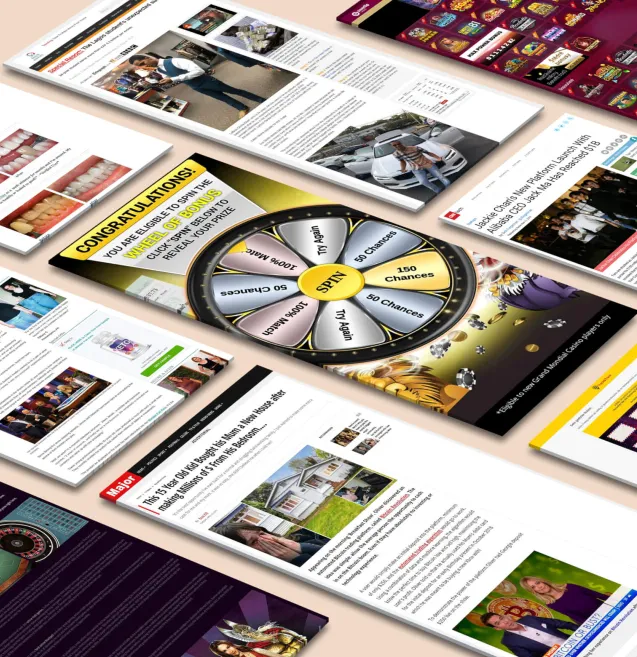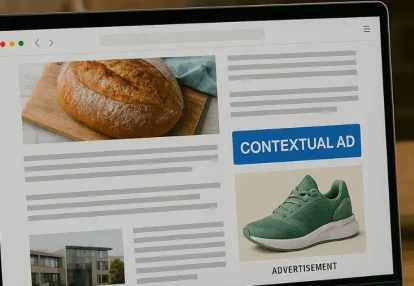
Our spy tools monitor millions of native ads from over 60+ countries and thousands of publishers.
Get StartedNative advertising has transformed the digital marketing landscape by seamlessly blending promotional content with the organic user experience. Unlike traditional banner ads that interrupt your browsing, native ads integrate naturally into the platform's content flow, making them feel less like advertisements and more like valuable information.
The numbers speak for themselves: native ads consistently outperform display ads, achieving click-through rates that can be four times higher than their traditional counterparts. This performance gap isn't accidental—it's the direct result of contextual relevance and strategic placement.
Increasing CTR with contextual relevance in native placements requires understanding how to match your ads with the right content, at the right time, for the right audience. When you master contextual native ads and native ad relevance optimization, you create advertising experiences that users actually want to engage with.
This article will show you exactly how to increase CTR native advertising campaigns through proven contextual targeting techniques that deliver measurable results.
Native advertising seamlessly integrates promotional content into the natural flow of a platform's editorial environment. Unlike traditional display ads that interrupt the user experience with banners, pop-ups, or sidebar placements, native ads match the form and function of the content surrounding them. You'll find them appearing as sponsored articles on news sites, promoted posts in social media feeds, or recommended content widgets at the end of blog posts.
The performance gap between these two advertising approaches is substantial. Display ads typically struggle with click-through rates hovering around 0.05%, while native advertising consistently delivers CTRs of 0.2% or higher—that's a four-fold improvement. I've seen campaigns where native placements outperformed display banners by even wider margins, particularly in content-heavy environments.
However, improving the performance of display ads is not impossible. There are several strategies that publishers can implement to increase banner ads CTR, which could significantly enhance their effectiveness.
The superior user engagement in native ads stems from three core advantages:
Users spend comparable time engaging with native ads as they do with editorial content, treating sponsored material as a natural extension of their content discovery journey rather than an unwelcome interruption.
Contextual relevance is the key to successful native advertising campaigns. When you match your ad content with the surrounding editorial environment, you create a natural connection between what users are already interested in and what you're offering. This connection isn't just about placing ads on related pages—it's about understanding the user's mindset at that exact moment.
Ad relevance optimization works by analyzing the content users are consuming and matching it with appropriate advertising messages. When someone reads an article about home renovation, they're likely to engage with ads featuring interior design services or power tools. The content has already captured their attention and established a specific context, making your ad feel like a helpful extension rather than an interruption.
Contextual targeting for native placements delivers measurable results through several proven strategies:
You'll see the impact immediately. Travel ads placed within destination guides convert at significantly higher rates than those scattered across general news sites. The key lies in creating a seamless experience where your ad answers questions users are already asking themselves.
User experience in native advertising directly impacts your campaign's success. When you prioritize seamless integration, you create an environment where users willingly engage with your content rather than actively avoiding it.
Traditional display formats create significant friction in the browsing experience. Banner blindness has become a documented phenomenon where users unconsciously ignore banner-like information on websites. Pop-ups interrupt reading flow, forcing users to hunt for close buttons. These intrusive formats generate frustration, leading to reducing ad fatigue and plummeting engagement rates. Display ads typically achieve CTRs around 0.05%, partly because users have trained themselves to avoid these disruptive elements.
Native ads take a different approach. By matching the visual design, format, and tone of the surrounding content, you eliminate the jarring interruption that kills engagement. Users consume these ads as part of their natural content discovery process, spending comparable time with native placements as they do with editorial content.
Increasing CTR with Contextual Relevance in Native Placements requires maintaining this delicate balance:
When you execute these techniques properly, native ads become valuable content recommendations rather than obstacles to overcome, naturally driving CTRs above 0.2%.
Behavioral targeting transforms how you connect with your audience by analyzing user actions, browsing patterns, and content preferences. When you track which articles users read, how long they stay on specific pages, and what topics they engage with most, you create detailed profiles that inform your ad placement decisions. This data-driven approach ensures your native ads appear in front of users who have demonstrated genuine interest in related content.
Machine learning in advertising takes this precision to another level. These algorithms continuously analyze performance data, identifying patterns human marketers might miss. You can deploy machine learning tools to automatically adjust bid strategies, rotate creative variations based on performance, and predict which placements will generate the highest engagement. The technology learns from every impression and click, refining your targeting parameters in real-time to maximize CTR.
Personalized native ads deliver content that speaks directly to individual user interests. When you combine behavioral insights with dynamic creative optimization, you can serve different ad variations to different audience segments. A user who frequently reads technology reviews sees native ads featuring the latest gadgets, while someone browsing fitness content encounters health-related products. This level of personalization creates relevance that static, one-size-fits-all campaigns cannot match.
The data proves the impact: personalized native advertising campaigns consistently achieve CTRs 2-3 times higher than generic approaches. You're not just placing ads—you're creating meaningful connections with users who are already primed to engage with your message.
Mobile native advertising requires a specific strategy that goes beyond simply resizing desktop ads to fit smaller screens. It's important to understand that mobile users engage with content in a different way—they scroll quickly, have shorter attention spans, and want immediate satisfaction.
The key to improving mobile click-through rates (CTR) is to use responsive ad formats that can adjust smoothly to different screen sizes. Your native ads should load just as fast as the surrounding editorial content. For example, when a user clicks on an article about fitness equipment, an instantly loading ad for workout supplements that is relevant to the topic feels like a seamless part of their reading experience. In contrast, a slow-loading banner ad that interrupts their flow will result in lower engagement.
To achieve fast loading native ads, you need to optimize aggressively:
Position your ads in areas where mobile users naturally take breaks—between paragraphs, after the first screen of content, or within content feeds. For instance, a travel blog reader who is scrolling through destination guides will be more likely to engage with a hotel booking ad placed after the third paragraph rather than one squeezed into the header.
Utilize mobile-specific heatmaps to test your ad placements and determine where users actually look and tap on their devices. This data will help you optimize your ad positioning for maximum visibility and engagement.
Rich media native ads are changing the advertising game by getting people to interact with them way more than regular banners. These ads use things like videos, animations, and interactive features to grab attention while still fitting in with the content they're placed in.
Think about how BuzzFeed's sponsored quizzes get millions of people involved by encouraging them to join in instead of just watching. These dynamic ad creatives make ads feel like experiences, with users spending an average of 3-5 minutes engaging with interactive content compared to only a few seconds on traditional display ads.
Video content within native placements performs exceptionally well, particularly when the video autoplays silently and includes captions. The New York Times' "T Brand Studio" demonstrates this approach effectively, creating cinematic brand stories that users watch through to completion at rates exceeding 70%.
Increasing CTR with Contextual Relevance in Native Placements becomes exponentially more powerful when paired with rich media formats. Interactive calculators, 360-degree product views, and swipeable image galleries invite exploration while respecting the user's browsing context. These formats create meaningful brand connection through native ads by offering genuine value rather than interruption.
The numbers tell the story: native ads featuring rich media elements achieve click-through rates (CTRs) between 0.3% and 0.5%, significantly outperforming static alternatives. You'll find that combining contextually relevant placement with engaging creative formats creates a multiplier effect on campaign performance.
Tracking your native ad performance requires dedicated analytics tools for CTR optimization that go beyond surface-level metrics. You need platforms that measure how different contextual segments influence click-through rates across various content environments. Google Analytics, combined with native advertising platforms like Taboola or Outbrain's built-in dashboards, gives you granular insights into which contextual placements drive the highest engagement.
A/B testing native ads becomes your most powerful weapon for improvement. You should test different combinations of contextual targeting parameters—comparing technology content placements against lifestyle sections, or testing morning versus evening audience segments. Run these tests for at least two weeks to gather statistically significant data. I've seen campaigns where changing just the contextual category improved CTR by 40%.
Heatmaps for ad placement reveal exactly where users' eyes travel on publisher pages. Tools like Hotjar or Crazy Egg show you which native ad positions receive the most visual attention. You might discover that mid-article placements in finance content outperform end-of-article spots by 3x, or that right-rail positions in mobile news apps get completely ignored.
Track these specific metrics for contextual targeting success:
The benefits of contextual targeting in native advertising are clear: higher engagement, better user experience, and significantly improved click-through rates. You've seen how increasing CTR with contextual relevance transforms native placements from simple advertisements into valuable content experiences that resonate with your audience.
Increasing CTR with Contextual Relevance in Native Placements isn't just about better numbers—it's about creating meaningful connections between your brand and potential customers at the exact moment they're most receptive.
Start leveraging contextual targeting techniques today to unlock the full potential of your native advertising campaigns. Test different contextual segments, analyze your data, and refine your approach. Your improved CTR is waiting.
Receive top converting landing pages in your inbox every week from us.
How-To
Native ads can do more than drive clicks—they can build long-term brand loyalty. Learn how to use authentic storytelling, strategic placement, and audience targeting to strengthen trust during year-end campaigns. Discover how subtle, value-driven messaging keeps customers engaged beyond the holidays. Ideal for marketers aiming to turn seasonal buyers into loyal brand advocates.
Marcus Chen
7 minDec 15, 2025
Must Read
As third-party cookies fade away, contextual targeting is making a powerful comeback. Learn how to leverage native ads that align with user intent and content relevance to maintain high engagement and conversions. Discover modern tools and tactics that make cookie-free targeting both precise and scalable. Ideal for advertisers seeking privacy-friendly ways to drive performance in 2025 and beyond.
Liam O’Connor
7 minDec 9, 2025
Recently Updated
Native ads can make or break your holiday marketing success. Explore how to evaluate your recent campaigns and identify what worked—or what fell short—with native advertising. Learn key optimization tactics to boost engagement, strengthen audience trust, and increase conversions in future promotions. Ideal for marketers aiming to refine their ad strategies after the holiday rush.
Elena Morales
7 minDec 1, 2025




